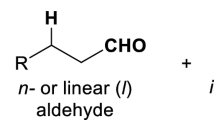Abstract
Flash photolysis of a 7-nitroindolinyl carbamate derivative in neutral aqueous solution rapidly generated a monoalkyl carbonate salt. The rate constant for subsequent decarboxylation of this salt [mono(2-phosphoryloxyethyl) carbonate], determined by rapid scan IR difference spectroscopy, was 0.4 s-1 at pH 7.0, 20 ◦C. This rate reflects release of the product alcohol upon photolysis of the parent compound. In general, alcohols protected as photolabile carbamate (or carbonate) derivatives will therefore be released too slowly for studies of the kinetics of millisecond time scale biological processes.
Similar content being viewed by others
References
T. Parman, J. A. Pincock and P. J. Wedge, The photochemistry of 1-naphthylmethyl carbonates and carbamates, Can. J. Chem., 1994, 72, 1254–1261
M. C. Pirrung and J. C. Bradley, Dimethoxy-benzoin carbonates: photochemically-removable alcohol protecting groups suitable for phosphoramidite-based DNA synthesis, J. Org. Chem., 1995, 60, 1116–1117
H. Giegrich, S. Eisele-Bühler, C. Hermann, E. Kvasyuk, R. Charubala and W. Pfleiderer, New photolabile protecting groups in nucleoside and nucleotide chemistry-synthesis, cleavage mechanisms and applications, Nucleosides Nu-cleotides, 1998, 17, 1987–1996
A. Bannerjee, K. Lee and D. E. Falvey, Photoreleasable protecting groups based on electron transfer chemistry. Donor sensitised release of phenacyl groups from alcohols, phosphates and diacids, Tetrahedron, 1999, 55, 12699–12710
T. Furuta, Y. Hirayama and M. Iwamura, Anthraquinon-2-ylmethoxycarbonyl (Aqmoc): a new photochemically removable protecting group for alcohols, Org. Lett., 2001, 3, 1809–1812
V. G. Robu, E. S. Pfeiffer, S. L. Robia, R. C. Balijepalli, Y. Q. Pi, T. J. Kamp and J. W. Walker, Localization of functional endothelin receptor signaling complexes in cardiac transverse tubules, J. Biol. Chem., 2003, 278, 48154–48161
A. Z. Suzuki, T. Watanabe, M. Kawamoto, K. Nishiyama, H. Yamashita, M. Ishii, M. Iwamura and T. Furuta, Coumarin-4-ylmethoxycarbonyls as phototriggers for alcohols and phenols, Org. Lett., 2003, 5, 4867–4870.
F. Afroz, A. D. Barone, P. A. Bury, C. Chen, A. Cuppoletti, R. G. Kuimelis, H. Li and G. H. McGall, Photo-removable protecting groups for in situ DNA microarray synthesis, Clin. Chem., 2004, 50, 1936–1939
S. Loudwig and M. Goeldner, N-Methyl-N-(o-nitrophenyl)carbamates as photolabile alcohol protecting groups, Tetrahedron Lett., 2001, 42, 7957–7959.
G. Papageorgiou and J. E. T. Corrie, Synthesis and properties of carbamoyl derivatives of photolabile benzoins, Tetrahedron, 1997, 53, 3917–3932.
J. E. T. Corrie, A. Barth, V. R. N. Munasinghe, D. R. Trentham and M. C. Hutter, Photolytic cleavage of 1-(2-nitrophenyl)ethyl ethers involves two parallel pathways and product release is rate limited by decomposition of a common hemiacetal intermediate, J. Am. Chem. Soc., 2003, 125, 8546–8554.
Y. V. Il’ichev, M. A. Schwörer and J. Wirz, Photochemical reaction mechanisms of 2-nitrobenzyl compounds: methyl ethers and caged ATP, J. Am. Chem. Soc., 2004, 126, 4581–4595.
F. M. Rossi and J. P. Y. Kao, Nmoc-DHBQ, a new caged molecule for modulating sarcoplasmic/endoplasmic reticulum Ca2+ ATPase activity with light flashes, J. Biol. Chem., 1997, 272, 3266–3271
K. C. Hansen, B. E. Schultz, G. Wang and S. I. Chan, Reaction of Escherichia coli cytochrome bo3 and mitochondrial cytochrome bc1 with a photoreleasable decylubiquinol, Biochim. Biophys. Acta, 2000, 1456, 121–137.
C. K. Sauers, W. P. Jencks and S. Groh, The alcohol-bicarbonate-water system. Structure-reactivity studies on the equilibria for formation of alkyl monocarbonates and on the rates of their decomposition in aqueous alkali, J. Am. Chem. Soc., 1975, 97, 5546–5553
Y. Pocker, B. L. Davison and T. L. Deits, Decarboxylation of monosub-stituted derivatives of carbonic acid. Comparative studies of waterand acid-catalyzed decarboxylation of sodium alkyl carbonates in H2O and D2O, J. Am. Chem. Soc., 1978, 100, 3564–3567.
J. Morrison, P. Wan, J. E. T. Corrie and G. Papageorgiou, Mechanisms of photorelease of carboxylic acids from 1-acyl-7-nitroindolines in solutions of varying water content, Photochem. Photobiol. Sci., 2002, 1, 960–969.
G. Papageorgiou and J. E. T. Corrie, unpublished data.
J. Alexander, M. A. Renyer and H. Veerapanane, A convenient method for the conversion of halides to alcohols, Synth. Commun., 1995, 25, 3875–3881.
P. Laszlo and A. Cornélis, ‘Claycop’, a user-friendly oxidizing and nitrating reagent, Aldrichim. Acta, 1988, 21, 97–103.
G. Papageorgiou and J. E. T. Corrie, Regioselective nitration of 1-acyl-4-methoxyindolines leads to efficient synthesis of a photolabile L-glutamate precursor, Synth. Commun., 2002, 32, 1571–1577.
J. D. Margerum and C. T. Petrusis, The photodecarboxylation of nitrophenylacetate ions, J. Am. Chem. Soc., 1969, 91, 2467–2472
P. Wan and S. Muralidharan, Structure and mechanism in the photo-retro-aldol type reactions of nitrobenzyl derivatives. Photochemical heterolytic cleavage of C–C bonds, J. Am. Chem. Soc., 1988, 110, 4336–4345.
F. S. Parker, Applications of Infrared Spectroscopy in Biochemistry, Biology and Medicine, Plenum, New York, 1971, p. 365.
N. B. Colthup, L. H. Daly and S. E. Wiberley, Introduction to Infrared and Raman Spectroscopy, Academic Press, New York, 2nd edn., 1975, pp. 303–304.
W. P. Jencks, Infrared measurements in aqueous media, Methods Enzymol., 1963, 6, 914–928.
C. Ho and J. M. Sturtevant, The kinetics of hydration of carbon dioxide at 25°, J. Biol. Chem., 1963, 238, 3499–3501.
J. N. Butler, Carbon Dioxide Equilibria and their Applications, Addison-Wesley, Reading, MA, 1982, pp. 21–23.
A. Barth and J. E. T. Corrie, unpublished data.
G. Papageorgiou and J. E. T. Corrie, Effects of aromatic substitution on the photocleavage of 1-acyl-7-nitroindolines, Tetrahedron, 2000, 56, 8197–8205.
A. Barth, K. Hauser, W. Mäntele, J. E. T. Corrie and D. R. Trentham, The photochemical release of ATP from ‘caged ATP’ studied by time-resolved infrared spectroscopy, J. Am. Chem. Soc., 1995, 117, 10311–10316.
Author information
Authors and Affiliations
Corresponding author
Additional information
Electronic supplementary information (ESI) available: Figs. S1 and S2. See http://www.rsc.org/suppdata/pp/b4/b417153e/
Rights and permissions
About this article
Cite this article
Papageorgiou, G., Barth, A. & Corrie, J.E.T. Flash photolytic release of alcohols from photolabile carbamates or carbonates is rate-limited by decarboxylation of the photoproduct. Photochem Photobiol Sci 4, 216–220 (2005). https://doi.org/10.1039/b417153e
Received:
Accepted:
Published:
Issue Date:
DOI: https://doi.org/10.1039/b417153e




